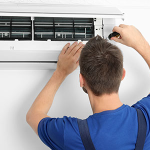The Comprehensive Guide to Ceiling Fan Installation and Safety
In the warm climate of Brisbane, ceiling fans have become an indispensable feature in many homes. They offer a cost-effective way to circulate air, making those hot summer days more bearable. But beyond their functional benefits, there’s an art and science to their installation and safety that every homeowner should be aware of.
The Role of Electricians in Ceiling Fan Installations
Certainly, in Brisbane, entrusting the task of ceiling fan installation to a qualified electrician is not just a common practice but also a commendable one. Electricians possess a comprehensive understanding of the electrical intricacies involved in such installations. Their expertise ensures that the fan is not only securely anchored but also electrically safe, minimising potential hazards.
Furthermore, a professional electrician is well-versed in the local building codes and regulations, ensuring that the installation adheres to all safety standards. They can also provide valuable insights into the optimal placement of the fan for efficient air circulation. Additionally, in the event of any unforeseen complications, such as the need for additional wiring or addressing pre-existing electrical issues, an electrician is best placed to handle these challenges proficiently.
The Key Point of Ceiling Fan Installation
The fundamental principle of ceiling fan installation is twofold: ensuring the fan is anchored securely and guaranteeing its electrical safety. Brisbane, with its sporadic bouts of stormy weather, presents a unique challenge. A ceiling fan that is installed meticulously can endure the gusty conditions that such weather brings. For homeowners, this translates to not just comfort but also an invaluable peace of mind, knowing that their fan is both safe and durable.
Steps to Brace an Electrical Ceiling Fan
In the context of Brisbane’s residential structures, the act of bracing a ceiling fan is of paramount importance. The process, while seemingly straightforward, requires precision and attention to detail. Here’s an elaborated guide:
- Identifying the Ceiling Joist: The first step involves pinpointing the location of a ceiling joist. This structural element is integral to providing the necessary support for the fan. A stud finder, a device adept at detecting framing studs behind the wall or ceiling surface, is the tool of choice for this task.
- Selection of the Right Outlet Box: Once the joist is located, the next step is the installation of an outlet box. However, not just any outlet box will suffice. It’s imperative to opt for a fan-rated outlet box. This variant is specifically engineered to bear the weight of the ceiling fan, ensuring that the fan remains steadfastly in place.
- Securing the Outlet Box: With the appropriate outlet box at hand, the final step is to affix it securely to the identified ceiling joist. This is achieved using suitable fasteners. It’s essential to ensure that these fasteners are not only of high quality but also compatible with the materials they are intended to bind. This meticulous approach guarantees the stability of the entire fan setup, laying the foundation for a safe and efficient operation.
Safety Concerns with ‘Used’ Ceiling Fans
The allure of a bargain, especially in Brisbane’s bustling online marketplace, can sometimes overshadow the potential risks associated with buying used items. This is particularly true for ceiling fans. Here’s what you should be wary of:
- Worn-out Parts: Over time, the components of a ceiling fan can deteriorate. This wear and tear might not be immediately visible, especially if you’re not familiar with the intricacies of fan mechanics. Bearings, for instance, can wear out, leading to a noisy or wobbly fan.
- Outdated Wiring: Older models or fans that have been in use for a long time might have outdated or deteriorated wiring. This poses a significant electrical hazard and can lead to short circuits or even fires.
- Lack of Warranty: Unlike new fans, used ones often come without a warranty. This means if something goes wrong, you’ll be shouldering the repair or replacement costs.
- Recommendation: If you’re considering a second-hand fan, it’s paramount to have it inspected by a qualified electrician before installation. They can assess its condition, identify potential hazards, and advise on its suitability.
Addressing Common Ceiling Fan Issues
Ceiling fans, like all appliances, can encounter issues over their lifespan. Here’s how to address some of the most common problems:
- Broken Blade: Brisbane’s humid and sometimes unpredictable climate can be tough on wooden fan blades. They can warp, crack, or even break entirely. If you notice any irregularities in the fan’s movement or sound, inspect the blades. An electrician or fan specialist can often replace these, restoring your fan to its optimal condition.
- Testing a Fan: If you’ve acquired a fan and are uncertain about its functionality, there’s no need to go through the entire installation process to test it. An electrician can conduct a preliminary test, ensuring all safety protocols are followed. This can save both time and potential hazards.
- Noisy Operation: A humming or rattling sound can indicate loose parts or issues with the motor. Regular maintenance checks can help identify and rectify such problems early on.
- Wobbling: A wobbling fan can be due to an imbalance in the blades or a loose component. It’s essential to address this promptly to prevent further damage or potential hazards.
Ceiling Fan and Electrical Fires: The Reality
The installation of ceiling fans, a common feature in many homes, is not without its potential hazards. One of the most pressing concerns surrounding these fixtures is the risk of electrical fires. Though such incidents are infrequent, the repercussions of an improperly installed fan can be severe. The root of the issue often lies in faulty wiring, the use of subpar components, or neglect in regular maintenance.
In a city like Brisbane, where the climate leans towards being hot and frequently dry, the importance of meticulous installation and upkeep of ceiling fans becomes even more pronounced. These climatic conditions can inadvertently heighten the vulnerabilities of electrical appliances, making them more susceptible to malfunctions if not appropriately managed.
To counteract these risks, several measures need to be diligently followed. Firstly, the wiring of the fan must adhere to the highest standards. Any compromise in this area can lead to short circuits, which are primary culprits for electrical fires. Secondly, it’s imperative to utilise components that meet or exceed the recommended standards. Opting for cheaper, inferior parts might offer short-term financial savings, but the long-term risks, both in terms of safety and potential repair costs, far outweigh the initial benefits.
Furthermore, regular maintenance plays a pivotal role in ensuring the longevity and safety of ceiling fans. Over time, wear and tear can degrade the efficiency and safety of the fan. Regular checks by professionals can identify potential issues before they escalate, ensuring that the fan operates both optimally and safely.
The Intricacies of DIY Ceiling Fan Installation in Brisbane
In the heart of Brisbane, the spirit of do-it-yourself (DIY) projects is palpable among its residents. The city’s inhabitants often take pride in their ability to handle various tasks around the home. However, when it comes to the installation of ceiling fans, the situation becomes a tad more complex. The process is not merely about attaching a fan to the ceiling; it encompasses a series of intricate steps that demand precision and expertise.
Ensuring the fan is securely mounted is just the tip of the iceberg. The wiring, often a maze of colours and connections, needs to be correctly set up to ensure the fan functions optimally and safely. Furthermore, post-installation safety checks are crucial to ensure that everything is in order and there are no potential hazards. Given these complexities, even the most seasoned DIY enthusiast might find the task daunting.
In cities like Brisbane, where the climate and architectural nuances play a significant role, having specialised local knowledge becomes an invaluable asset. Thus, while the allure of a DIY project might be tempting, hiring a professional for ceiling fan installation is often the wiser choice. Not only does it guarantee a seamless and safe installation, but it also offers peace of mind, knowing that potential risks have been mitigated.
Electrical Specifications for Ceiling Fan Installations
Ceiling fans, despite their apparent simplicity, come with distinct electrical prerequisites essential for their safe and efficient functioning. Advanced models, particularly those with integrated lighting or remote controls, often demand specialised wiring configurations to ensure seamless operation without overburdening the electrical system. Some of these fans might even require dedicated circuits, especially if they have high power consumption or incorporate heating elements.
Beyond wiring, the choice of electrical outlet is paramount. Given the weight and dynamic nature of ceiling fans, which produce vibrations during operation, a robust outlet is needed. This is where the fan-rated box, a specific electrical outlet designed for ceiling fans, comes into play. Built to support the fan’s weight and counter its vibrations, this box ensures the fan’s secure anchoring. Given the intricacies and potential risks, consulting a professional electrician or technician before installation is always a prudent choice.
Ceiling Fan Installation: Costs, Safety, and Types
In the dynamic environment of Brisbane, the decision to install a ceiling fan is influenced by a myriad of factors, ranging from financial considerations to safety protocols and the specific type of fan suitable for a given space.
Cost and Time Considerations
The financial outlay associated with installing a ceiling fan in Brisbane is contingent on several variables. The complexity of the chosen fan model, coupled with the existing wiring infrastructure of the home, plays a pivotal role in determining the overall cost. On average, Brisbane homeowners might anticipate an expenditure bracket of $100 to $300 for a standard ceiling fan installation. While the majority of installations are completed within a few hours, the duration is not set in stone. Depending on the intricacies and unique challenges of each project, the time frame can fluctuate.
Safety Considerations
Safety, as with any electrical installation, is of paramount importance. A fundamental yet crucial step in ensuring a safe installation environment is to deactivate the power at the circuit breaker before commencing any work. This precaution, though elementary, is instrumental in averting potential electrical accidents and ensuring the safety of both the installer and the home’s occupants.
Axial Fans vs. Ceiling Fans
Lastly, when deliberating on the type of fan to install, it’s essential to distinguish between axial fans and ceiling fans. Axial fans, primarily designed for ventilation purposes, are not typically suited for overhead installations in residential settings. Their design facilitates efficient air movement in a specific direction, making them ideal for tasks like expelling stale air or introducing fresh air into spaces. In contrast, ceiling fans are crafted with the express purpose of being mounted overhead in living spaces. Their design ensures the circulation of air, enhancing the comfort of the room’s occupants by either cooling the space during warmer months or redistributing warm air during colder periods.
In essence, while the allure of a ceiling fan is evident, especially in Brisbane’s climate, it’s imperative to approach the installation process with an informed perspective, prioritising safety, cost-effectiveness, and the selection of the appropriate fan type.
Assessing Your Light Fixture for Ceiling Fan Support
In many Brisbane homes, transitioning from a light fixture to a ceiling fan is a sought-after modification. However, this isn’t as simple as swapping one for the other due to the distinct weight and operational dynamics of ceiling fans. Before initiating the installation, it’s imperative to assess the structural integrity of the existing fixture. Ceiling fans are inherently heavier than most standard light fixtures, and their operational dynamics, involving rotation and potential vibration, necessitate a robust support system. The primary step is to inspect the current fixture’s brace. Standard light fixture braces might be ill-equipped to handle the weight and forces of a ceiling fan, making the presence of a fan-rated brace essential for safety.
Alongside the brace, the significance of the box, to which the fan or light fixture is affixed, cannot be understated. Traditional light fixture boxes might falter under the demands of a ceiling fan. In contrast, a fan-rated box, designed specifically for the weight and vibrations of ceiling fans, is crucial. These reinforced boxes, complemented by sturdy mounting hardware, ensure a secure installation. Given Brisbane’s warm climate and the resultant dependence on ceiling fans, it’s paramount for homeowners to ensure a safe installation. Consulting with a professional electrician or installer can provide a thorough assessment and guide the necessary modifications, offering homeowners both a secure installation and peace of mind.
The Pivotal Role of Ceiling Fans in Brisbane Living
Ceiling fans, beyond their primary function of air circulation, have become emblematic of the quintessential Brisbane home, offering a blend of comfort and aesthetic appeal. In a city where temperatures can soar, these fans serve as a respite, providing a cooling effect that’s both energy-efficient and environmentally friendly. However, their benefits are best realised when due diligence is given to their installation and maintenance. By investing time in understanding the nuances of ceiling fan safety and ensuring professional standards are adhered to, Brisbane homeowners can seamlessly integrate these appliances into their living spaces, reaping their advantages whilst ensuring a safe and harmonious environment.





